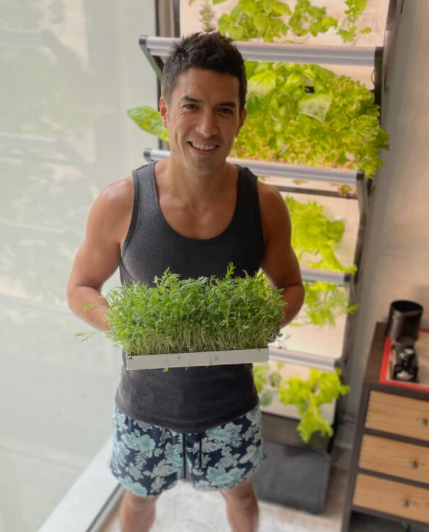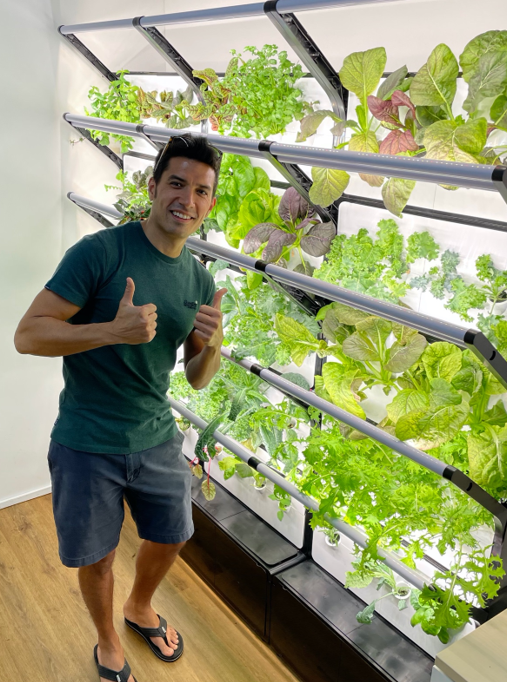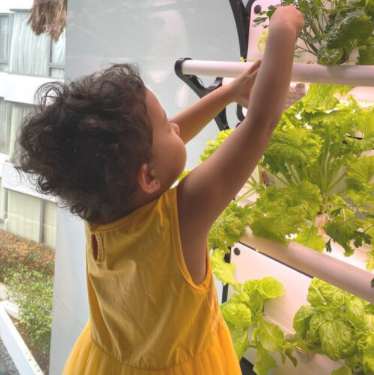Vertical Farming – An Interview With Mathew Howe
 Mathew Howe
Mathew Howe
Mathew is currently founder of Grobrix. A company that designs and manufactures indoor vertical farms for both home and work. Prior to this he worked at BNP Paribas.
Mathew gained a 1st Class Honours in Mechanical Engineering at Imperial College London. He is currently based in Singapore.
Following on from our Eddy Warren interview, we talked to Mathew about vertical farming, hydroponics and the future of farming.
Q) Firstly, what made you jump from finance to hydroponics or indoor farming?
Good question! As you outline above, I studied Engineering and so have some skills that I never really got to explore when working in financial markets. I wanted to create and build something that people could touch and use. I’m also a father of two young girls and there was a time when green pasta was on the lunch menu every day. Often the local supermarket simply could not fulfil the household basil needs. So… I started growing it. Very soon, I realised that I needed to start growing indoors to escape the heat and pests which are a real problem for many leafy greens here in Singapore. There was not a product out there in the market that had both the functionality and aesthetic that I wanted for my dining and kitchen area. So… I started designing one.
Q) What is Grobrix? How did you come up with the name?
Grobrix is the world’s first modular edible hydroponic wall. An attempt to blend the aesthetics of a green wall with the sustenance functionalities of modern precision farming. I wanted to take hi-tech farming out of the warehouse or shipping container and put it out in the broader community for people to enjoy looking at before they enjoy eating from it. The name Grobrix came from the two words ‘Grow’ and ‘Bricks’.
Q) How much energy do these vertical farms use? How much space do you need for one? What types of vegetables can you grow?

The single stack in the picture above draws around 100W and this is primarily for the artificial lighting which comes from LEDs. The lighting runs for 12 hours a day. Horticultural LEDs are very efficient now which is why this is possible now and wasn’t 10 years ago. They produce very little heat which means you can position the lights close to the plants. A single Grobrix stack has a footprint 65cm wide and 30cm deep. It has a modular design so you can stack them next to each other too as in the below picture. You can grow leafy greens, herbs and select fruiting crops like dwarf tomatoes. We are also experimenting now with edible flowers and microgreens.
Q) What were the challenges of designing and manufacturing the product?
There were many. Re-learning CAD. Learning how to 3D print to iterate and test the design. Convincing a manufacturer here in Singapore to help me mass produce it. Raising capital to pay the manufacturer.
Q) Why should people grow their own food? What are the benefits?
Many reasons. Here are a few!
A more sustainable tomorrow. Agricultural runoff is responsible for more ecosystem disruption than any other single form of pollution. It is estimated that produce in the United States travels approximately 1,500 miles to get from farm to plate. These ‘food miles’ are a large part of your meal’s carbon footprint. Estimates show that fifty percent of all produce grown is wasted. When was the last time you threw out a bag of salad?
Self-sufficiency. For many countries, most of the food is imported. This often leaves us vulnerable to food supply disruptions when borders become less porous.
Be healthier, be happier! If your produce comes through traditional farming methods, you and your family are likely consuming pesticides, insecticides and herbicides. These are bad and there are many studies that show they have long term health implications. Studies have proven that plants improve concentration and productivity, purify the air you breathe, reduce stress levels, and boost your mood.
Eat better tasting food. Farm to table in 20 minutes. It just tastes better when you grow it yourself.
Educate and inspire. Population migration towards cities has detached society’s relationship with food and where it comes from. Educate and inspire future generations for a more sustainable tomorrow.
Lifestyle! Growing plants is a fulfilling and enjoyable pastime.
Q) How easy is it to get into hydroponics?
Easy to get started. Hard to master. At Grobrix we are trying to design a recipe (equipment to make it easy for everyone).
Q) Singapore imports around 90% of its food. How much CO2 does growing food at home save?
That’s a difficult question to answer. There are many things to consider. For example:
- What is the CO2 cost of flying a bag of leaves around the world? Believe it or not, I can buy a bag of lettuce in the supermarket here that’s come all the way from Mexico.
- 50% of all produce grown ends up in a landfill. 30% of all produce that arrives at the supermarket does not leave with a customer. What is the CO2 (equivalent) of the methane that is produced from this? Around 10% of greenhouse gases globally come from food waste.
- What is the CO2 cost of destroying the wilderness for industrial agriculture?
Q) You have both home and commercial vertical farms, have these been successful in Singapore? Are you/have you gone international?
We are selling the Grobrix experience to homes and commercial customers. We are not commercial vertical farmers. We do not sell our produce. The concept is to place Grobrix in the workplace, schools, restaurants, bars, hotels, hospitals, retirement homes, social clubs and health clubs as well as homes. We then provide a ‘Personal urban farmer’ service to provide the material inputs, the support and the education. The idea is to promote farming as a lifestyle endeavour for urban communities; something to bring people together. Once we verify the model in Singapore, we shall then move to international markets.
Q) Where do you see the future of farming heading? How do you think climate change will impact global farming? Will everyone need an indoor farm?
Industrial agriculture as it currently exists is not sustainable (for many reasons that are beyond the scope of this interview – but please watch ‘Kiss the ground’ or ‘A life on this planet’ on Netflix to find out more). Climate change is driving several changes in the space now. The development of synthetic proteins is one, given that current livestock farming methods will not be able to feed the world’s growing population in a sustainable manner. The other is vertical and hi-tech farming for produce. This is primarily for leafy greens now, but I am looking forward to seeing how the space develops for larger fruiting crops or even root-based crops like carrots.
Does everyone need an indoor farm? No. But growing your own food is a good way to be more sustainable, healthier and happier. So, from that perspective, I think we should all give it a shot!
Q) Do you feel indoor vertical farms could work well in third world countries?
This comes down to economics. Who will pay for the farms and who will buy the produce? Farming indoors to escape the elements and maximise yield comes at a financial cost. I would love to think they can work in third world countries but vertical farming in first world countries is still quite a low margin business and often relies on government support. Will third world governments be able to help?
Q) Finally, how long before your chief salad muncher becomes the CEO?

I started Grobrix because I wanted to do my part to help the environment with the limited resources that I have. I suppose that a big part of my reason for doing this is for my children, and one day, my children’s children. If Grobrix is still around by the time my little girl is old enough to be a CEO, then I think I’ll be a very happy old man.


